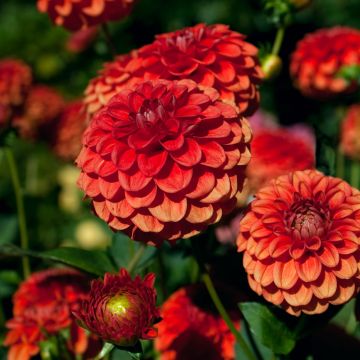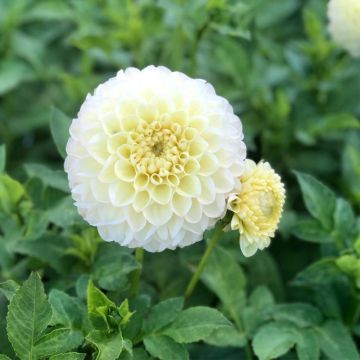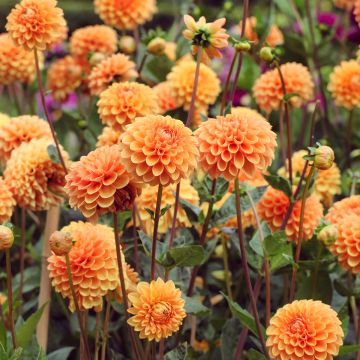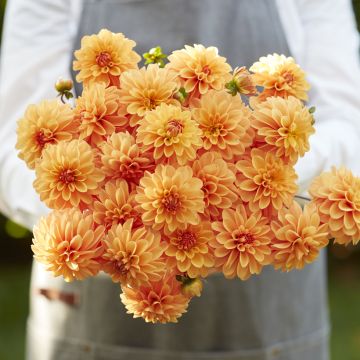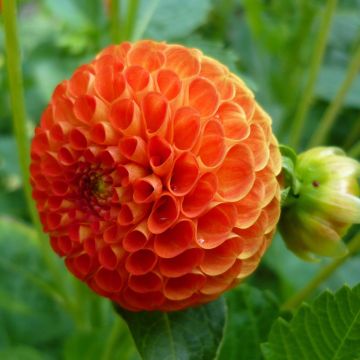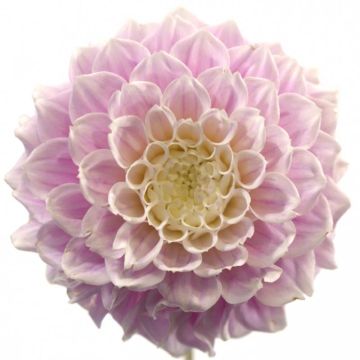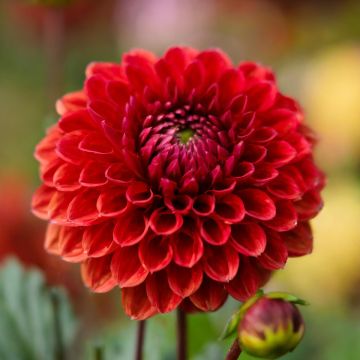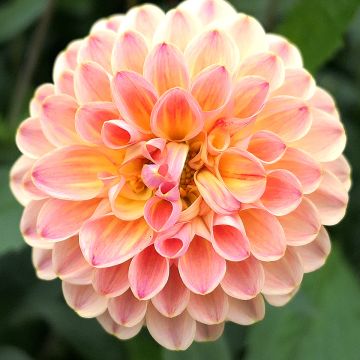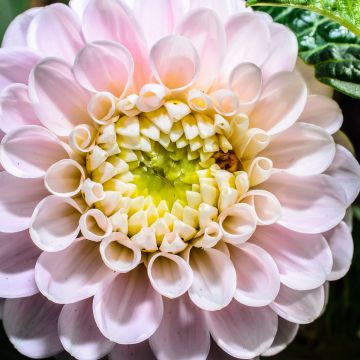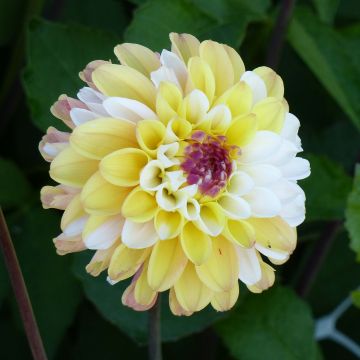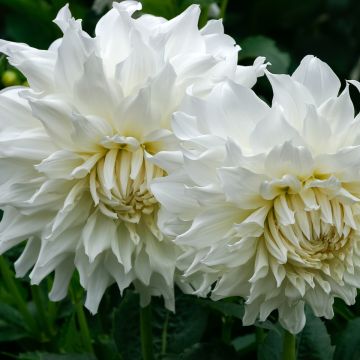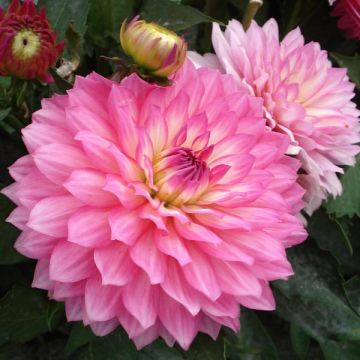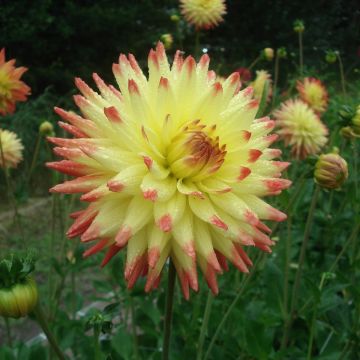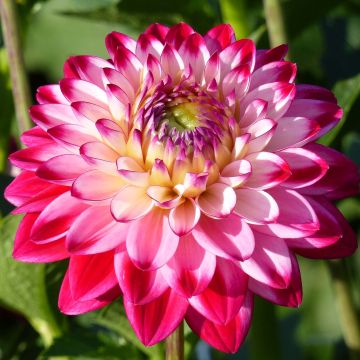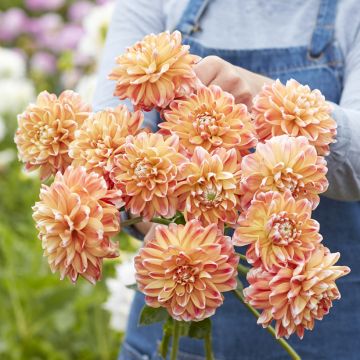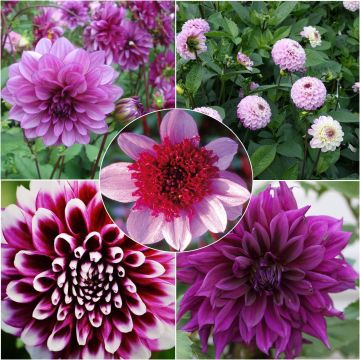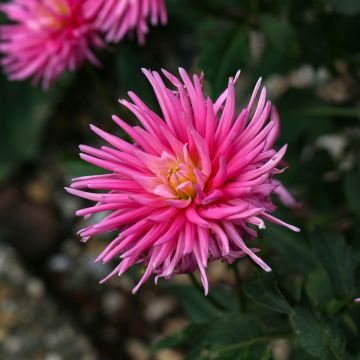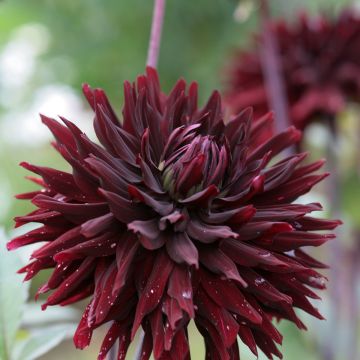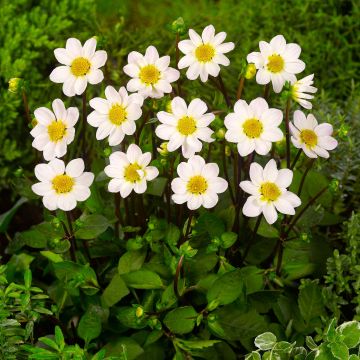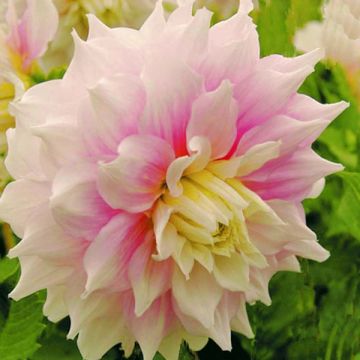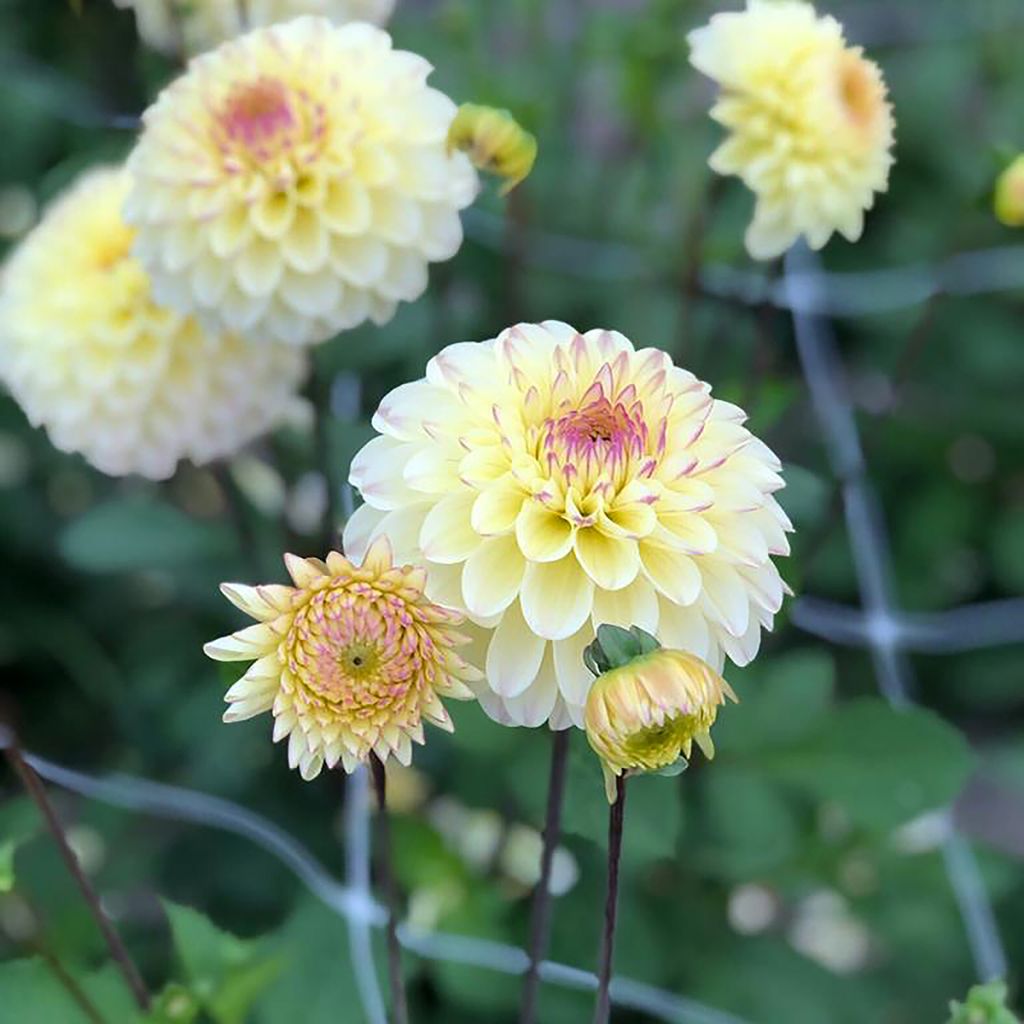

Dahlia balle Isa's Favorite
Dahlia Isas Favourite
Dahlia Isa's Favorite
Dahlia
This item cannot be shipped to the selected country
Delivery charge from €5.90
More information
Schedule delivery date,
and select date in basket
This plant carries a 6 months recovery warranty
More information
We guarantee the quality of our plants for a full growing cycle, and will replace at our expense any plant that fails to recover under normal climatic and planting conditions.
From €5.90 for pickup delivery and €6.90 for home delivery
Express home delivery from €8.90.
Does this plant fit my garden?
Set up your Plantfit profile →
Description
Dahlia 'Isa's Favourite' is a variety of Dahlia known as a 'ball' Dahlia, with flowers that display a pale yellow colour, slightly more lemony in the centre, delicately tipped with lavender pink at the heart. Of medium size, with slightly flattened pompom-like shapes, they are organized in numerous alveoli that play with the light and give them relief. The plant, of medium stature, blooms abundantly, from summer to frost, on long and sturdy green stems, with a flawless appearance in bouquets as well as in flower beds. Its tenderly coloured flowers will be magnificent with asters or the blooming of grasses.
Dahlias belong to the Asteraceae family, they are originally from the high plateaus of Mexico and bear inflorescences in heads, which we commonly call 'flowers'. Currently, the thousands of horticultural varieties obtained by humans have invaded, to our greatest pleasure, gardens all over the world.
The 'Isa's Favourite' variety will measure about 1m (3ft) in height and 70cm (28in) in diameter after 3 to 4 months of cultivation. It is classified among the Dahlias of the decorative group with Ball-type flowers. In this category, the heads are without a visible heart, and they are composed of numerous regularly arranged and completely rolled up petals (ligules), tubular and never flaring. It includes varieties that form true balls, like pompoms (diameter less than 6cm (2in)) and balls (diameter greater than 6cm (2in)). The heads of this 'Isa's Favourite' variety generally measure 9-10cm (4in) in diameter. The plant has an erect and bushy habit. The flowering of this variety starts in July and ends in October-November, if care is taken to remove faded flowers or frequently make bouquets. The very branching stems are long and sturdy, hollow, and the leaves are opposite, pinnately lobed, meaning they divide into 3 or 5 very toothed lobes. The leaves here are a fairly dark green and the stems are tinged with purple.
To encourage flowering again, take care to cut off faded flowers, or even better, regularly make large colourful bouquets by combining it with other varieties. 'Isa's Favorite' produces very pretty flowers in bouquets, accompanied by single or pompom-like varieties, in white, pastel pink or salmon. In flower beds, this glorious Dahlia will create very colourful spots alongside grasses like squirrel's tail barley and cordifolius asters ('Little Carlow'), for example, which bloom at the same time. Its long, very flowery stems allow for the decoration of bouquets until late in the season.
As a star plant for borders and herb gardens, Dahlias confidently accompany the most beautiful flowers, but are also appreciated alongside vegetable plants. In Mexico, this tuberous plant was initially cultivated as a root vegetable for consumption. However, its poor taste qualities assigned it the status of an ornamental plant. The Dahlia, with its infinitely varied shapes and colours, is now considered one of the most beautiful flowers in the garden.
Report an error about the product description
Dahlia Isas Favourite in pictures
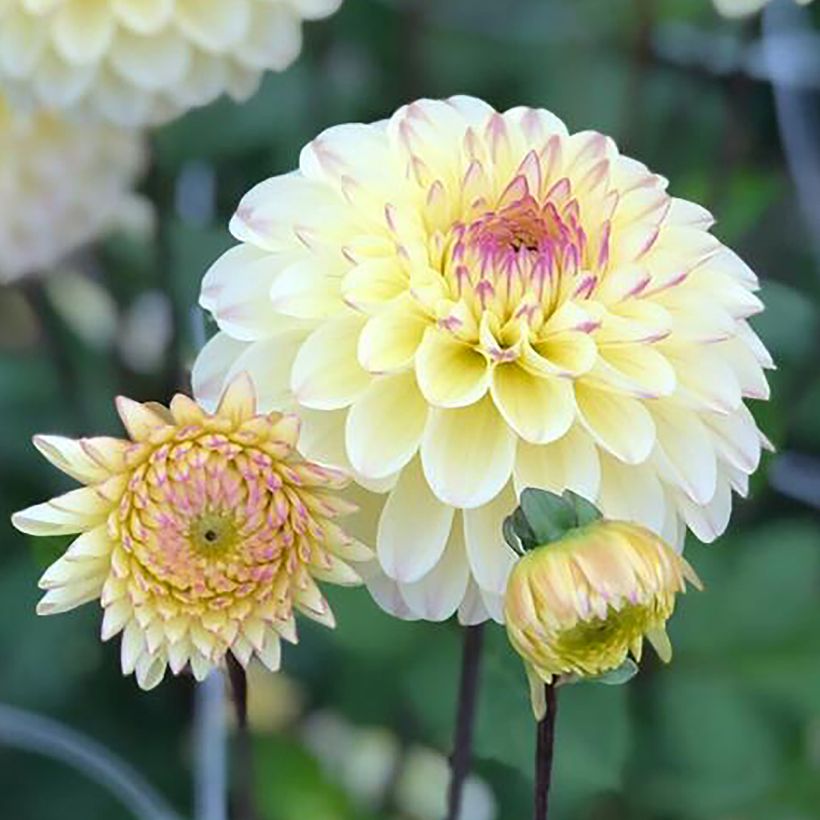

Plant habit
Flowering
Foliage
Botanical data
Dahlia
Isa's Favorite
Asteraceae
Dahlia
Cultivar or hybrid
Other Pom-pom Dahlias
Planting and care
Dahlia 'Isa's Favourite' is easy to grow in all regions. For abundant flowering, it is good to follow a few simple rules: plant the tubers in full sun as soon as the last frost has passed, rich, fresh, and well-drained soil is perfect. However, stagnant moisture would promote the rotting of the tubers. Do not hesitate to amend the soil with compost and sand if necessary. Work the soil deeply and enrich it, for example, with crushed horn or dehydrated blood. Place your tuber and crumble the soil well to fill without air pockets. Your dahlia should be covered with about 6cm (2in) of soil. At the end of planting, water once abundantly, then repeat this watering regularly during the first 6 weeks to help with rooting.
Dahlias are sensitive to cold, so they need to be overwintered. In November, the first frost causes the foliage to turn black, which is the time to dig them up. Carefully remove the tubers. Remove as much soil as possible. Let the foliage dry so that the tubers can replenish their reserves. Then cut the stems to 10cm (4in). Spread your bulbs in a crate on newspaper. Store them in a frost-free, dry, cool, and dark place, such as a frost-free garage or attic, for example. In southern regions, close to the coast, where there are only a few days of frost per year, it is possible to leave them in place. In this case, simply cover the ground with a carpet of leaves or straw for protection.
Planting period
Intended location
Care
This item has not been reviewed yet - be the first to leave a review about it.
Dahlias
Haven't found what you were looking for?
Hardiness is the lowest winter temperature a plant can endure without suffering serious damage or even dying. However, hardiness is affected by location (a sheltered area, such as a patio), protection (winter cover) and soil type (hardiness is improved by well-drained soil).

Photo Sharing Terms & Conditions
In order to encourage gardeners to interact and share their experiences, Promesse de fleurs offers various media enabling content to be uploaded onto its Site - in particular via the ‘Photo sharing’ module.
The User agrees to refrain from:
- Posting any content that is illegal, prejudicial, insulting, racist, inciteful to hatred, revisionist, contrary to public decency, that infringes on privacy or on the privacy rights of third parties, in particular the publicity rights of persons and goods, intellectual property rights, or the right to privacy.
- Submitting content on behalf of a third party;
- Impersonate the identity of a third party and/or publish any personal information about a third party;
In general, the User undertakes to refrain from any unethical behaviour.
All Content (in particular text, comments, files, images, photos, videos, creative works, etc.), which may be subject to property or intellectual property rights, image or other private rights, shall remain the property of the User, subject to the limited rights granted by the terms of the licence granted by Promesse de fleurs as stated below. Users are at liberty to publish or not to publish such Content on the Site, notably via the ‘Photo Sharing’ facility, and accept that this Content shall be made public and freely accessible, notably on the Internet.
Users further acknowledge, undertake to have ,and guarantee that they hold all necessary rights and permissions to publish such material on the Site, in particular with regard to the legislation in force pertaining to any privacy, property, intellectual property, image, or contractual rights, or rights of any other nature. By publishing such Content on the Site, Users acknowledge accepting full liability as publishers of the Content within the meaning of the law, and grant Promesse de fleurs, free of charge, an inclusive, worldwide licence for the said Content for the entire duration of its publication, including all reproduction, representation, up/downloading, displaying, performing, transmission, and storage rights.
Users also grant permission for their name to be linked to the Content and accept that this link may not always be made available.
By engaging in posting material, Users consent to their Content becoming automatically accessible on the Internet, in particular on other sites and/or blogs and/or web pages of the Promesse de fleurs site, including in particular social pages and the Promesse de fleurs catalogue.
Users may secure the removal of entrusted content free of charge by issuing a simple request via our contact form.
The flowering period indicated on our website applies to countries and regions located in USDA zone 8 (France, the United Kingdom, Ireland, the Netherlands, etc.)
It will vary according to where you live:
- In zones 9 to 10 (Italy, Spain, Greece, etc.), flowering will occur about 2 to 4 weeks earlier.
- In zones 6 to 7 (Germany, Poland, Slovenia, and lower mountainous regions), flowering will be delayed by 2 to 3 weeks.
- In zone 5 (Central Europe, Scandinavia), blooming will be delayed by 3 to 5 weeks.
In temperate climates, pruning of spring-flowering shrubs (forsythia, spireas, etc.) should be done just after flowering.
Pruning of summer-flowering shrubs (Indian Lilac, Perovskia, etc.) can be done in winter or spring.
In cold regions as well as with frost-sensitive plants, avoid pruning too early when severe frosts may still occur.
The planting period indicated on our website applies to countries and regions located in USDA zone 8 (France, United Kingdom, Ireland, Netherlands).
It will vary according to where you live:
- In Mediterranean zones (Marseille, Madrid, Milan, etc.), autumn and winter are the best planting periods.
- In continental zones (Strasbourg, Munich, Vienna, etc.), delay planting by 2 to 3 weeks in spring and bring it forward by 2 to 4 weeks in autumn.
- In mountainous regions (the Alps, Pyrenees, Carpathians, etc.), it is best to plant in late spring (May-June) or late summer (August-September).
The harvesting period indicated on our website applies to countries and regions in USDA zone 8 (France, England, Ireland, the Netherlands).
In colder areas (Scandinavia, Poland, Austria...) fruit and vegetable harvests are likely to be delayed by 3-4 weeks.
In warmer areas (Italy, Spain, Greece, etc.), harvesting will probably take place earlier, depending on weather conditions.
The sowing periods indicated on our website apply to countries and regions within USDA Zone 8 (France, UK, Ireland, Netherlands).
In colder areas (Scandinavia, Poland, Austria...), delay any outdoor sowing by 3-4 weeks, or sow under glass.
In warmer climes (Italy, Spain, Greece, etc.), bring outdoor sowing forward by a few weeks.

































